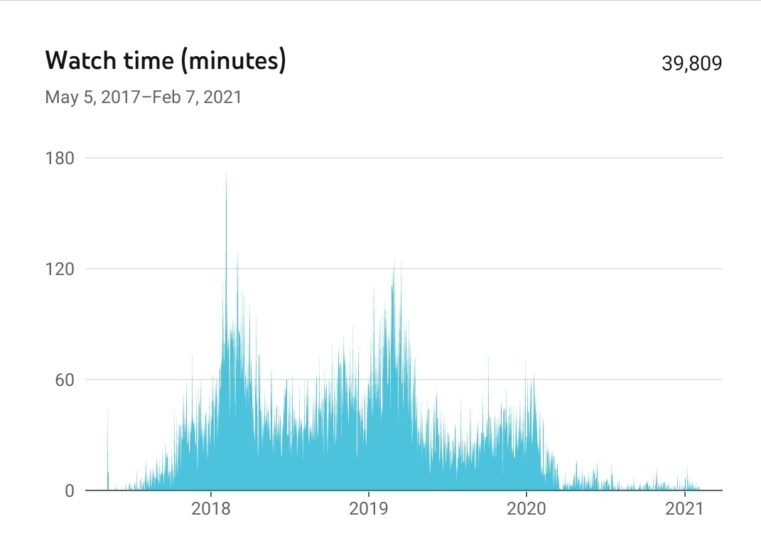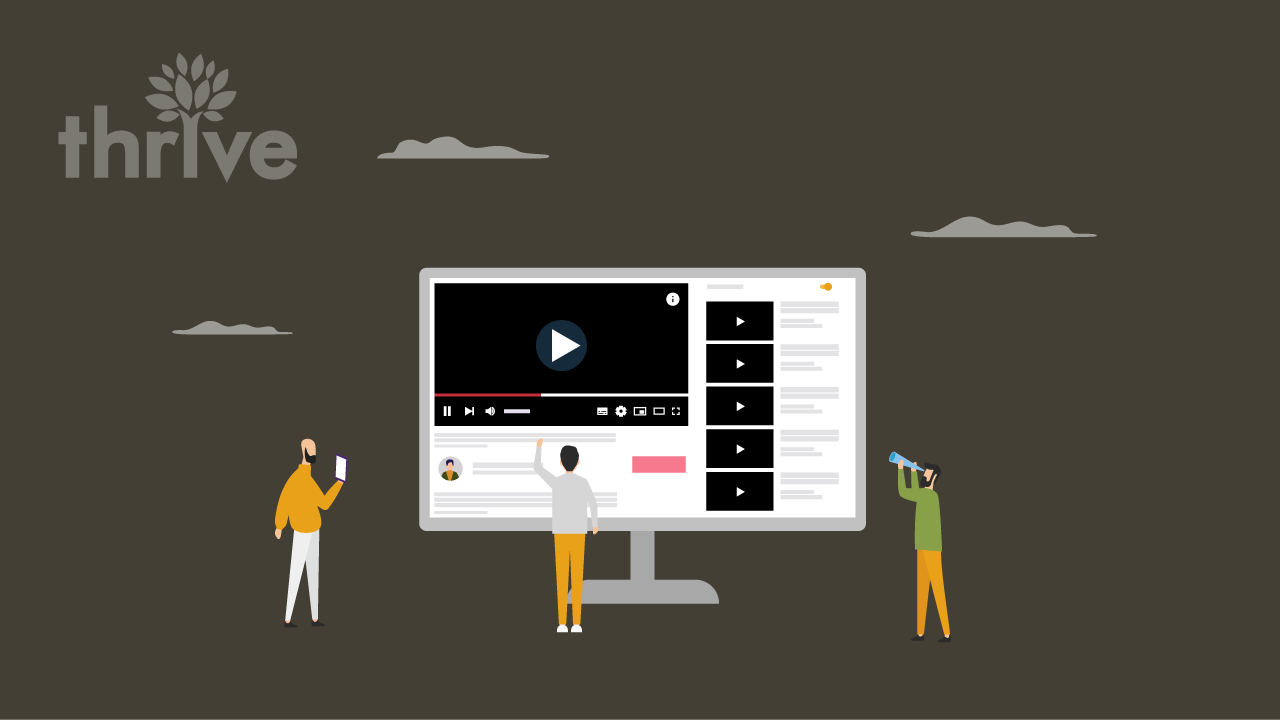As digital marketing has evolved, video has quickly become the go-to content format for people researching products or services before buying them. Videos educate, entertain and engage, eventually driving conversions. Video speaks to many audiences, including the 2.74 billion monthly active users on YouTube.
YouTube remains a powerful video marketing platform despite being overcrowded. Here, the challenge for brands is to rank high and be visible to the right audience. And if there’s one ranking factor to focus on in your YouTube marketing strategy and content creation, it’s watch time.
What is watch time on YouTube? Measured in minutes, it’s the aggregate time your viewers have spent watching your video over a time period (e.g., 28 days, 90 days or lifetime). YouTube watch time is:
• Better than click-through rate (CTR) at capturing engagement. While CTR shows the percentage of people who clicked on your video after seeing it on YouTube, it doesn’t tell you how many abandoned it while watching.
• Not to be confused with YouTube audience retention, which measures the percentage of your video that people have watched. For instance, if someone watches the first five minutes of a 10-minute video, its YouTube audience retention is 50 percent.
What is watch time on YouTube good for? If your content keeps racking up minutes, YouTube identifies it as a source of relevant information to a wide audience, and the higher it goes in the search rankings.
But increasing your watch time to aim for or maintain your top spot is not as easy as it sounds. Don’t worry, though. This article provides you with combined practical and technical tools to improve your average YouTube watch time. We talk about:
• What is a good watch time on YouTube?
• What are the best practices for increasing watch time?
• More YouTube search engine optimization (SEO) and YouTube conversion rate optimization (CRO) tips
What Is a Good Watch Time on YouTube?
The average YouTube watch time depends on your niche or industry. Sometimes, it even depends on your brand. But to give you an idea, average YouTube watch time is 41.9 minutes per day for viewers 18 years and older (Source: Hootsuite). Meanwhile, the audience retention YouTube prefers is 50 percent.
5 Best Practices for Increasing YouTube Watch Time
Increasing your watch time impacts your YouTube search engine optimization (SEO) and YouTube conversion rate optimization (CRO). That’s because higher watch time positions you at the top of YouTube search results and improves your chance at conversion.
Here are ways to optimize your YouTube video marketing and maximize those minutes:
1. Deliver a Killer Opener
You have 15 seconds to hook your audience; what do you do? Let’s quickly run through a list of effective video openers and discuss why it’s important to catch viewers’ attention in the first few seconds.
• Start with a question, a statistic, a quote, a joke or anything that piques their interest.
• Address a pain point and promise them a solution (best told through a story).
• Offer them value. Answer: “What’s in it for them?”
• Employ some zippy animation or motion. You can use a template across your videos, especially if you tend to group them by category. Check out the opener of the series, “What You Don’t Know,” narrated by no less than Sean Astin (of the Lord of the Rings fame) for inspiration.
An effective opener speaks to the shrinking attention span of humans, but it also aims to deliver value. Getting your audience on board means you can reduce bounce rates, which is good for YouTube SEO. Bounce rate refers to the percentage of visitors who left a site after viewing a single page.
2. Leverage YouTube Audience Retention
Working on the audience retention YouTube metric can affect a video’s watch time. Look at the image below. By the 1:35 mark, the video already lost half of its audience. If there were 1,000 initial viewers, the watch time YouTube would report at 50 percent audience retention would be around 790 minutes. But if it retained all of them at the same mark, the video would have clocked around 1,580 minutes. Remember that attention retention of 50 percent is ideal for YouTube SEO.

3. Create Longer Videos
If you could make a six-minute video instead of a three-minute one about an irresistible topic, go for it. Say 1,000 people saw each video in its entirety. The total watch time for the shorter video would be 3,000 minutes. But the longer one would have accumulated 6,000 minutes!
Of course, it’s obvious that you should not just lengthen a video for YouTube SEO optimization or YouTube CRO. Make it 10 minutes if you have something valuable to say and can keep the focus of your video throughout its length.
4. Zero In on Your Ideal Audience
It’s no secret that YouTube is saturated. In your industry, there might be hundreds of brands vying for the same people’s attention. How do you stand out from the crowd? Don’t make videos for everyone and hope it will land. Find a niche in your industry and target people who are interested in it. This is where audience persona research, a YouTube CRO tactic, comes in handy.
5. Craft a Value-Adding, High-Quality Video
For this section, we asked Thrive’s media specialist, Corbin Hubbard, to break down the components of a well-made video. Here are the top four factors on his list:
• Content/story is king
Humans relate to brands, ideas, products and services when they’re presented in a story. Your target customers or clients will relate more if you make them the hero of the story you’re telling.
• Good-quality sound
Audio is an overlooked part of videos, but it’s a powerful tool to evoke emotions in your audience. Think about the properly timed music or sound effects in your favorite film.
• Good-quality lighting
This speaks to both the quality of your lighting equipment and lighting techniques. Playing with shadow and light allows you to give visual depth to your video. Also, knowing when to use high-key lighting (for marketing and promotional videos) or low-key lighting (best for serious or moody narrative videos) benefits your YouTube optimization efforts.
• Well-crafted title and description
Per YouTube SEO best practices, include your exact-match keyword in the title and broad-match keyword in the description. Make sure the usage flows naturally.
Paying attention to these aspects can boost your watch time and YouTube engagement rate. Marketers may differ in how they compute YouTube engagement rate, but here’s the most common method:
total likes + total comments / total views
Advanced Tips: YouTube Search Engine Optimization and YouTube Conversion Rate Optimization
As a metric, what is watch time on YouTube designed for? The answer is definitely YouTube optimization. At the same time, YouTube SEO optimization and YouTube CRO also contribute to watch time increase. Let’s take a closer look at the relationship between watch time and YouTube optimization:
Using Keywords Strategically
Part of YouTube SEO optimization is knowing how and when to deploy keywords. To increase watch time, include long-tail keywords, which resemble how searchers type their queries.
Here are some more practical tips from Thrive’s SEO strategist Steven Garcia:
• Keep video titles concise (between 60 and 70 characters) and at least five words long.
• Descriptions should be in the range of about 300-350 words and provide a summary of the video.
• Add tags to the video and ensure they are relevant to the video.
“These help YouTube watch time by making a video more relevant to the search intent, so it is of interest to the viewer,” added Garcia. “Otherwise, if the video description and title don’t match the content of the video, the viewer will find another video to watch.”
Delving Into YouTube Analytics
Tracking the watch time YouTube Analytics reports on is an important yet advanced part of your video marketing strategy on the platform. If this is your first time or you have forgotten how to use this tool, follow the steps below:
Step 1. Log into your Google/YouTube account. On a desktop browser, click on your profile and choose YouTube Studio from the drop-down menu. Alternatively (and a much quicker method), download the YouTube Studio app on your phone.
Step 2. On the app dashboard, your Analytics summary is displayed, including YouTube watch time. You can monitor your watch time for the last 28 days, 90 days, 365 days, lifetime or any custom timeline you set.
Step 3. You might need to hire an analyst to make sense of your data and turn it into actionable insights, or work with a company that specializes in YouTube marketing, including YouTube CRO.
You can also take a stab at simpler data sets, such as the lifetime watch time YouTube put together for the video produced by this travel magazine channel.

You can see a decline in accumulated watch time in 2020 when the pandemic hit. The dip has continued into 2021 because there’s less demand for travel now. One of the interesting questions for this video would be “How to align content topic creation with the current state of travel.”
Wrap-Up
We’ve packed this article with a good deal of actionable information, including the answers to “What is a good watch time on YouTube?” and “What is the audience retention YouTube recommends?” Our lists of best practices and advanced tips are designed to help you boost your YouTube engagement rate through a higher watch time. In turn, your videos rank higher, become more visible and achieve greater conversion.
However, continuing the winning cycle requires a sustained effort. As 90 percent of online shoppers rely on YouTube videos as a major part of their purchasing decisions, your brand’s content should stay ahead of the curve. This entails excellent video creation, a solid social media marketing strategy and comprehensive optimization.
Checking all the boxes is Thrive, a full-service digital marketing firm that specializes in SEO, CRO, YouTube video marketing and end-to-end video production services. We propel brands and businesses to the top of YouTube video search results, positioning them in front of their target audience at the right time through well-optimized, value-adding videos.
Shoot us a message or give us a call at 1-866-908-4748 to have one of our representatives contact you and talk through how to get from point A to launching your most engaging videos ever.





